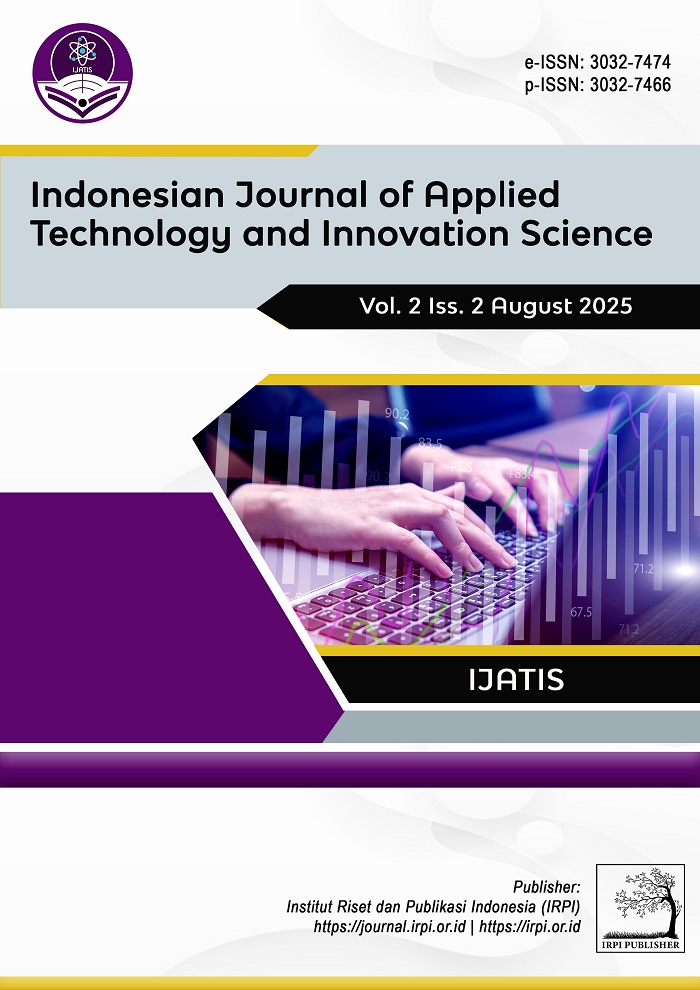PM 2.5 Prediction Using the Long Short-Term Memory Algorithm
Keywords:
Air Pollution, Long Short-Term Memory, Mean Absolute Percentage Error, PM 2.5Abstract
Air pollution poses a serious threat to human health and the environment, with far-reaching impacts on various aspects of life. Among its most harmful components is particulate matter less than 2.5 micrometers in diameter (PM2.5), which contributes significantly to degraded air quality. Accurate prediction of PM2.5 concentrations is crucial for public health protection and policy-making. This study employs the Long Short-Term Memory (LSTM) algorithm, a deep learning method well-suited for modeling large, complex, and time-dependent datasets, to forecast PM2.5 levels in Delhi, India. The dataset comprises daily records from January 1, 2015, to July 1, 2020. The proposed model achieved a Mean Absolute Percentage Error (MAPE) of 25.22%, indicating moderate predictive accuracy. These results demonstrate that the LSTM algorithm can serve as an effective tool for forecasting PM2.5 concentrations, providing valuable insights for air quality management and environmental planning.
References
E. I. S. M. Ja'far Sodiq, "Comparison of Naive Bayes and K-Nearest Neighbor Methods for Air Classification in DKI Jakarta," Yogyakarta, Dec. 2019.
K. Auliasari, M. Kertaningtyas, and J. Raya Karanglo Km, "Air Quality Analysis Using the K-Means Algorithm," 2021. [Online]. Available: http://e-journal.stmiklombok.ac.id/index.php/jireISSN.2620-6900
A. Khumaidi, R. Raafi, I. Permana Solihin, and J. Rs Fatmawati, "Testing the Long Short Term Memory Algorithm for Predicting Air Quality and Temperature in the City of Bandung,"Telematics Journal, flight. 15, no. 1, 2020.
Lingga Yuliana, "Analysis of Sales Planning Using the Time Series Method (Case Study at PD. Sumber Jaya Aluminum),"Management Partner (JMM Online), vol. 3, pp. 780–789, Jul. 2019.
Z. Zhang, Y. Zeng, and K. Yan, “A hybrid deep learning technology for PM2.5 air quality forecasting,” Environmental Science and Pollution Research, vol. 28, no. 29, pp. 39409–39422, Aug. 2021, doi: 10.1007/s11356-021-12657-8.
T. Xueet al., “Rapid improvement of PM2.5 pollution and associated health benefits in China during 2013–2017,” Sci China Earth Sci, vol. 62, no. 12, pp. 1847–1856, Dec. 2019, doi: 10.1007/s11430-018-9348-2.
N. S. Muruganandam and U. Arumugam, “Seminal Stacked Long Short-Term Memory (SS-LSTM) Model for Forecasting Particulate Matter (PM2.5 and PM10),” Atmosphere (Basel), vol. 13, no. 10, Oct. 2022, doi: 10.3390/atmos13101726.
G. I. Drewil and R. J. Al-Bahadili, “Air pollution prediction using LSTM deep learning and metaheuristics algorithms,” Measurement: Sensors, vol. 24, Dec. 2022, doi: 10.1016/j.measen.2022.100546.
B. Liu, Z. Yu, Q. Wang, P. Du, and X. Zhang, “Prediction of SSE Shanghai Enterprises index based on bidirectional LSTM model of air pollutants,” Expert Syst Appl, vol. 204, Oct. 2022, doi: 10.1016/new.2022.117600.
M. Krishan, S. Jha, J. Das, A. Singh, M. K. Goyal, and C. Sekar, “Air quality modelling using long short-term memory (LSTM) over NCT-Delhi, India,” Air Qual Atmos Health, vol. 12, no. 8, pp. 899–908, Aug. 2019, doi: 10.1007/s11869-019-00696-7.
P. J. Canatalay and O. N. Ucan, “A Bidirectional LSTM-RNN and GRU Method to Exon Prediction Using Splice-Site Mapping,” Applied Sciences (Switzerland), vol. 12, no. 9, May 2022, doi: 10.3390/app12094390.
Q.: Journalet al., “Dust Respirable Concentration ‘Particulate Matter’ (Pm2.5) And Health Disorders Communities In Settlement Around Electric Steam Power Plant,” PROMOTIVE, 2019.
T. Meidya and R. Yudhastuti, “Literature Review: Long-term Exposure to PM2.5 is at Risk of Increasing Mortality Due to COVID-19,” 2021.
M. Unik and Sri Nadriati, “Overview: Random Forest Algorithm for PM2.5 Estimation Based on Remote Sensing,” Jurnal CoSciTech (Computer Science and Information Technology), vol. 3, no. 3, pp. 422–430, Dec. 2022, doi: 10.37859/coscitech.v3i3.4380.
D. Saravanan and K. Santhosh Kumar, “Improving air pollution detection accuracy and quality monitoring based on bidirectional RNN and the Internet of Things,” Mater Today Proc, 2022, doi: 10.1016/j.matpr.2021.04.239.
S. Roy et al., “Deep Learning for Classification and Localization of COVID-19 Markers in Point-of-Care Lung Ultrasound,” IEEE Trans Med Imaging, vol. 39, no. 8, pp. 2676–2687, Aug. 2020, doi: 10.1109/TMI.2020.2994459.
J. Bi, L. Zhang, H. Yuan, and J. Zhang, “Multi-indicator water quality prediction with attention-assisted bidirectional LSTM and encoder-decoder,” Inf Sci (N Y), vol. 625, pp. 65–80, May 2023, doi: 10.1016/j.ins.2022.12.091.
A. Jain, A. Bhasin, and V. Gupta, “Prediction of air pollution using LSTM-based recurrent neural networks,” 2019. [Online]. Available: http://WorstPolluted.org
K. S. Rao, G. L. Devi, and N. Ramesh, “Air Quality Prediction in Visakhapatnam with LSTM based Recurrent Neural Networks,” International Journal of Intelligent Systems and Applications, vol. 11, no. 2, pp. 18–24, Feb. 2019, doi: 10.5815/ijisa.2019.02.03.
H. Yang, J. He, C. Zhou, and L. Li, “A Particulate Matter 2.5 Concentration Forecasting Method Based on Multi-Input LSTM,” in 2020 IEEE 6th International Conference on Computer and Communications, ICCC 2020, Institute of Electrical and Electronics Engineers Inc., Dec. 2020, pp. 1634–1638. doi: 10.1109/ICCC51575.2020.9344921.
S. Ferlito, F. Bosso, S. De Vito, E. Esposito, and G. Di Francia, “LSTM Networks for Particulate Matter Concentration Forecasting,” in Lecture Notes in Electrical Engineering, Springer, 2020, pp. 409–415. doi: 10.1007/978-3-030-37558-4_61.
L. Zhoul, M. Chenl, and Q. Ni, “A hybrid Prophet-LSTM Model for Prediction of Air Quality Index,” in 2020 IEEE Symposium Series on Computational Intelligence, SSCI 2020, Institute of Electrical and Electronics Engineers Inc., Dec. 2020, pp. 595–601. doi: 10.1109/SSCI47803.2020.9308543.
Y. Karyadi and H. Santoso, "Air Quality Prediction Using LSTM, Bidirectional LSTM, and GRU Methods,"Journal of Informatics Engineering and Information Systems, flight. 9, no. 1, pp. 671–684, Mar. 2022.
M. P. Ningrum, R. Mutia, H. Azmi, and H. D. Khalifah, “Sentiment Analysis of Twitter Reviews on Google Play Store Using a Combination of Convolutional Neural Network and Long Short-Term Memory Algorithms,” Public Research Journal of Engineering, Data Technology and Computer Science, vol. 2, no. 2, pp. 107–115, Jan. 2025, doi: 10.57152/predatecs.v2i2.1625.
M. F. Fayyad, V. Kurniawan, M. R. Anugrah, B. H. Estanto, and T. Bilal, “Application of Recurrent Neural Network Bi-Long Short-Term Memory, Gated Recurrent Unit and Bi-Gated Recurrent Unit for Forecasting Rupiah Against Dollar (USD) Exchange Rate,” Public Research Journal of Engineering, Data Technology and Computer Science, vol. 2, no. 1, pp. 1–10, Apr. 2024, doi: 10.57152/predatecs.v2i1.1094.










